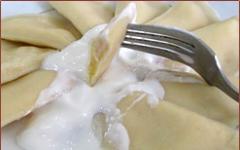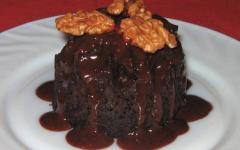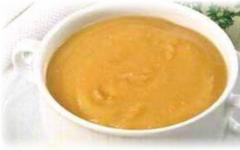Your little miracle still can’t do a lot. He has not yet been able to explain what exactly worries or interests him, so his mother has to guess about everything herself. For example, why does a child arch? If he cries at the same time, you should be wary. After all, such body movements may be signs of some kind of disease. Let's look at this in more detail.
Why does the child arch? Signs of the disease
1. One of the reasons for your baby's anxiety may be increased intracranial pressure. But this (admittedly very controversial) diagnosis is accompanied by some signs: the newborn has an enlarged fontanel, and the venous network on the head is clearly visible. Your baby often spits up, is lethargic and does not gain weight well - all this, in addition to arching of the back, should alert the mother and force her to consult a neurologist.
2. High muscle tone. To check this, place your palm under the back of the baby’s head and try to use it to tilt the baby’s head down so that his chin touches his chest. If this is difficult, then the child has an elevated blood pressure and needs the help of specialists. Usually, such toddlers are prescribed a massage, they are offered to carry the child “in a column” and rub a special gel into the lumbar and neck area.
3. Colic is also the reason why yours arches backwards. Unfortunately, this phenomenon is not uncommon: colic occurs in three-week-old babies and, as a rule, significantly decreases by 4 months of age. Signs of this problem are the baby crying, during which he may pass gas, legs drawn up to the tummy and an arched back. Colic occurs in the late afternoon and causes a lot of unpleasant moments for both the baby and his parents. To alleviate your baby's condition, contact your pediatrician.
Why does the child arch? He will know the world!

If your inquisitive treasure sees something interesting behind him, then this will also be followed by an arching of his back. True, the baby will not be capricious. Turn the little explorer to face the object of interest and let him take a good look at everything.
But with the help of arching the back, the child can demonstrate his character. As a rule, such “lunges” are accompanied by grunting and angry snorting. In this way, the baby tries to determine for himself the boundaries of what is permitted and makes his first attempts to influence his mother. Such situations are natural and require the mother to be able to calmly and confidently guide the baby and not be led by his desires and whims.
As the child grows up, he bends backward, trying to roll over onto his tummy in order, for example, to reach a toy. At first he has difficulty doing this - help him. A little later, the baby will be able to do such an important movement himself.
So what to do?

As you already understand, you can figure out why the child is arching. To do this, you just need to carefully watch him. After all, the cause may be either a stuffy nose (usually the baby can be heard “grunting”) or a little person. The main thing is not to fuss and panic. And if you suspect a disease, consult a doctor. Grow up healthy!
Very often, mothers get scared when they notice their baby’s unusual behavior. In some cases, this is a sign of growth, the child mastering control of his body, or a manifestation of curiosity. But there are a number of cases when an urgent visit to a doctor can protect you from tragic consequences.
How to react to new parents if their baby, lying on his back, arches and throws his head back? This action stands out so much from the overall picture of a cute lying and sleeping baby doll that we immediately rush to our grandmothers, neighbors, friends, doctors and, of course, look for answers on the Internet. As a rule, the one who seeks finds. And moms scare themselves and dads with terrible diagnoses, terrible consequences and heartbreaking pictures of the future. And now the baby, who arches in the crib and throws back his head, seems to us doomed and mortally ill.
Why can a baby arch his back and still cry?
How can you not go crazy, but also not miss an important symptom? To do this, it is worth understanding the reasons, features and possible consequences of such behavior. In general, the described manifestation is a component of hypertonicity - a normal phenomenon in 99.9% of newborns. Hypertonicity is increased tone, tension in all the muscles of the baby’s body. It can appear with varying strength and frequency, and, as a rule, goes away by four months. However, in combination with other manifestations it can be a sign of a disease. So, let's consider all possible options and solutions.
Standard options
Let's figure out why the baby throws his head back and bends back. Mom doesn't need to panic if:

The baby spent nine months in quite cramped space inside the mother, and now it should take no less time to master the endless world. Therefore, strange postures during sleep or movements of arms and legs are his way of understanding the world around him.
What can you do?
If the mother is still anxious, then you can carry out excellent activities that calm the mother and are harmless to the baby. Namely:

In what cases should you visit a doctor?
From the first days the baby delivers to his mother serious anxiety - any movement is recognized as dangerous, and an extra squeak is a signal of distress. In literature and folklore, the nervousness of mothers has become the talk of the town. However, it is worth noting that there are diseases whose diagnosis at such early stages is critically important. So what should young parents do?
First of all, watch your child carefully and check with your doctor if you notice:
- Throwing back the head causes blueness in the area between the nose and lips, as well as trembling of the lower jaw.
- The baby rolls his eyes or bulges out, the pupil trembles, and begins to squint noticeably.
- The baby's head grows asymmetrically and too quickly in relation to the whole body.
 Why should you pay attention to these symptoms? This is because these signs may indicate an increase in intracranial pressure, and are the reason for an early visit to a neurologist. In this case, the doctor will prescribe additional research. One type of study can be neurosonography - a painless procedure. Essentially, this is an ultrasound of the baby's brain.. If carried out in a timely manner, it allows you to avoid many undesirable consequences and stop developing diseases. One of these diseases is hydrocephalus, which occurs 1 time in 4,000 children.
Why should you pay attention to these symptoms? This is because these signs may indicate an increase in intracranial pressure, and are the reason for an early visit to a neurologist. In this case, the doctor will prescribe additional research. One type of study can be neurosonography - a painless procedure. Essentially, this is an ultrasound of the baby's brain.. If carried out in a timely manner, it allows you to avoid many undesirable consequences and stop developing diseases. One of these diseases is hydrocephalus, which occurs 1 time in 4,000 children.
Symptoms of intracranial pressure, in addition to arching and throwing back the head are:
- Dehiscence of the sutures of the skull. Everyone knows that in newborns the skull bones are not in close proximity to each other, and grow together by the end of the first year of life. If you notice that the distance between them is changing towards increasing, this is a cause for concern.
- Bulging of the fontanel. Babies have two fontanelles - one on the parietal part of the skull, the other on the occipital part.
- Exceeding the norms for head circumference. The circumference is measured from the front - along the brow ridges (about one centimeter above the eyebrows), and from the back - along the most protruding part of the back of the head. However, if the dimensions go beyond the norm, then the first thing you should do is take a closer look at the parents’ childhood photos - sometimes the non-standard shape of the skull is hereditary and does not pose a threat to the baby’s health.
It is important to remember that making a diagnosis based on one symptom is wrong. Only together they give a picture of increased intracranial pressure. One symptom is not yet an indicator.
You should also see a doctor in the following cases:

There are cases where such restless behavior of a baby helped to detect meningitis at an early stage.
As a rule, by 4 months hypertonicity in newborns it disappears on its own. If this does not happen, this is also another reason to seek additional examination.
If hypertonicity has not disappeared after this period, if the arms and legs are bent, and when straightened, they immediately return to this state - this is a cause for serious concern. After all, it is precisely such manifestations that are a sign of possible damage to cerebral palsy. In most cases, its cause is hypoxia (insufficient oxygen supply) of the baby’s brain in late pregnancy, during childbirth, and even in the first months of the baby’s independent life.
Let's sum it up
 The arching of the back itself and tilting the head back do not mean a terrible diagnosis. Most likely, the baby is exploring the world, learning to control his still unruly arms and legs, and simply developing at his own special pace. Parents should not take serious measures unless it is accompanied by convulsions and continuous crying.
The arching of the back itself and tilting the head back do not mean a terrible diagnosis. Most likely, the baby is exploring the world, learning to control his still unruly arms and legs, and simply developing at his own special pace. Parents should not take serious measures unless it is accompanied by convulsions and continuous crying.
If, in addition to this, there are other symptoms listed above, then a visit to an experienced specialist will help either calm fears or catch the development of the disease in time.
However, in both cases, both water procedures and light massages will be useful. And also good nutrition, good mood and healthy sleep for mom, whose emotions the baby still perceives as his own.
Parents' concerns when newborn baby arches his back strongly and throws his head back, it’s easy to understand. The unusual condition of the baby may be associated with poor health.
We will look at the reasons why it is really worth contacting a pediatrician and neurologist, and quite harmless manifestations that may be associated with the baby’s age.
When is there no need to worry?
You can independently check whether your baby has “habit” of throwing the head back. To do this, lay him on his back, holding him by the handles, and pull them a little, but not too much, keep this in mind.
If the head immediately deviates and this position persists, beware. If it returns to its normal position, then everything is in order.
When the baby periodically sleeps on his back or side with head thrown back– This is normal up to 4 months of age.
Sometimes it is necessary to carefully shift the child, give him a different position - so that he my neck didn't get stiff.
If the baby is capricious or just very excited, he can also arch. This is explained not only by instability immature nervous system, but also a physiological (natural) increase in the tone of the muscles of the cervical spine.
By the way, the neck and shoulders tense up even in adults at the moment of excitement. The best way is to adjust the baby's posture, turning him over on his tummy.
However, you need to consult a neurologist to know for sure that everything is fine with the spine. If deviations are detected, the doctor will prescribe procedures - for example, it helps a lot soothing massage.
 At the age of about two months, the baby becomes interesting to watch behind what is happening around him.
At the age of about two months, the baby becomes interesting to watch behind what is happening around him.
Newborns have insufficiently developed head turning skills. Therefore, to try to consider objects, behind, or reacting to sounds outside his field of vision, the child often arches back.
In addition, this way the baby can learn to take a different pose– for example, tends to roll over on its side, or throw back its head.
Watch your baby:
- How often does the head tilt become noticeable?
- what time of day does this happen;
- Are there any other unusual symptoms?
 There are more serious reasons why a baby arches his back and throws his head back. This behavior may be a consequence of a number of diseases or pathological conditions.
There are more serious reasons why a baby arches his back and throws his head back. This behavior may be a consequence of a number of diseases or pathological conditions.
As a result of birth trauma, torticollis (neck deformity) and dislocations often appear. Against the background of trauma, children's cerebral palsy.
A neurologist examines the baby already in the first month of life, so he will detect similar problems in the early stages and will prescribe treatment.
Even if the manifestations that cause you concern are not present at the time of examination, a competent doctor will still notice them.
 The consequence of prolonged labor, incorrect position of the fetus, especially if the baby is large - intracranial pressure.
The consequence of prolonged labor, incorrect position of the fetus, especially if the baby is large - intracranial pressure.
This can be observed by the trembling of the lower jaw when throwing back the head, as well as by blue skin(cyanosis) between your baby's nose and lips.
The baby sleeps poorly, wakes up frequently, and shows restlessness and irritability. Protrusion of the eyes and/or covering of the pupil with the lower eyelid is often noticeable. This state is reason to consult a specialist: It not only provokes headaches, but is also an obstacle to development.
 Physiological (normal) muscle tension, including the muscles of the limbs, is stably maintained for the first three months - as if repeating the “fetal position”, and finally disappears by six months.
Physiological (normal) muscle tension, including the muscles of the limbs, is stably maintained for the first three months - as if repeating the “fetal position”, and finally disappears by six months.
But increased tone can also be the result of a congenital neuromuscular disease, developmental disorders of the central nervous system.
Frequent, pronounced no head tilt observed in a healthy baby, you should remember this once and for all if you don’t want to harm the baby.
What to do to make sure you have hypertension:
- put the child on his tummy - with hypertonicity, the head will immediately tilt back and the shoulders will rise;
- when the baby is lying on his back, lift the back of his head with your palm and tilt him so that his chin touches his chest - the resistance of the neck muscles will be clearly felt.
Do not delay visiting a neurologist if the child cries quietly and “sluggishly”, burps frequently and a lot, and if you notice any of the above symptoms, do not hesitate to go to the doctor.
 Consultation with a doctor is also important in cases where the birth ended with a caesarean section, the baby born premature, with a breech presentation or entwined umbilical cord, or with excess weight, or when removing it, obstetric forceps were used.
Consultation with a doctor is also important in cases where the birth ended with a caesarean section, the baby born premature, with a breech presentation or entwined umbilical cord, or with excess weight, or when removing it, obstetric forceps were used.
If the doctor has conducted the necessary research and noticed abnormalities, do not despair. It's not too late to practice restoration of the nervous system.
Treatment (massage, gymnastics, physiotherapy, etc.) will relieve threatening symptoms and improve your baby’s health. And then his speech, thinking and coordination will develop normally.
Many young parents are faced with the fact that their infant arches his back, throws his head back, screams loudly and cries for a long time. In most cases, a baby who does not yet know how to speak expresses his dissatisfaction in this way.
However, in a number of situations, the listed phenomena may indicate serious pathological processes occurring in the baby’s body. For timely diagnosis and treatment of diseases in newborn babies and infants up to 6 months, parents must be able to determine why the baby sleeps poorly, arches his back when trying to stand on the bridge, throws his head back in sleep or while awake and often cries.

About baby behavior and parental fears
The birth of a child brings new parents not only joy, but also reasons for concern, because the baby still cannot explain if something worries or hurts him. During the first 5-6 months of life, children often cry, which is a sign of normality, since this is the only way they can inform adults about unpleasant or painful sensations.
However, if, in addition to crying, the baby throws his head back, arches his back, becomes restless during feeding, often wakes up at night or sleeps with his head thrown back, this behavior should not be ignored (see also:). The listed phenomena can be a sign of both physiological and pathological factors. Pediatricians urge parents who discover this behavior in newborns and infants not to worry ahead of time. In order to find out why the baby arches and throws back its head, you should definitely consult a doctor.
Why does a healthy baby arch and throw back his head?

Often, such symptoms are features of the child’s behavior and are not associated with any diseases. Pediatricians note that these positions are harmful for infants, especially at the age of 1–4 months, when their musculoskeletal system is still too weak. When a baby bends over, throwing his head back, he can seriously damage his back. To avoid negative consequences, parents are advised to stop such movements by moving the baby to a safe position. You also need to monitor the position of the baby during sleep and during feeding.
Stretches and kneads muscles
Since newborns and infants spend most of their time lying on their backs, with the help of such movements they stretch and knead stiff muscles. Parents have no reason to worry if the baby, after a long and sound sleep, arches his back and groans. At the same time, many babies pull their arms up and tuck their legs. After 2–3 months have passed since birth, with the help of such movements, babies begin to make attempts to roll over on their side or reach for a bright toy or other object that has attracted attention.
Expresses dissatisfaction (bored, wants to be held, doesn’t like food, tight or scratchy clothes)
Often this behavior of a baby indicates that he is uncomfortable. At the same time, he can whine and groan. In this case, it is enough to eliminate the factor causing discomfort to the baby. Often babies attract the attention of adults in this way if they:
- boring;
- I want to be in my mother’s arms;
- don’t like the taste of mother’s milk or baby food;
- you don’t want to tear yourself away from the breast during feeding, even after being completely full;
- unpleasant sensations upon contact with bed linen;
- uncomfortable in clothes;
- A wet sheet or diaper causes discomfort.
What if this is a symptom of a disease?

In some cases, arching of the back and throwing the head back by young children indicates a disease. In order to take timely measures to eliminate its symptoms, you need to carefully monitor the baby’s behavior and know how, in addition to such movements, these pathologies manifest themselves. Most often, children arch and throw back their heads due to abdominal pain, increased muscle tone and intracranial pressure.
Hypertonicity of the back and neck muscles
Many babies are diagnosed with this condition within the first month of life. Impaired muscle tone, which is often accompanied by arching of the back and throwing back of the head, is considered a temporary phenomenon. Up to 3 months of age, this condition is a variant of the norm and in forms not burdened by complications does not require special treatment. You can recognize this syndrome yourself:
- if a baby, lying on his stomach, throws his head back strongly and raises his shoulders without using his hands, this indicates hypertonicity of the spinal muscles;
- If, when trying to lower the child’s chin to the chest while lying on his back, difficulty is felt, we are talking about increased tone of the neck muscles.
In addition, this syndrome may be accompanied by symptoms such as:
- refusal of food;
- cry;
- inability to extend the limbs to the sides;
- complete or partial lack of reaction to light and sound.
Increased ICP (Komarovsky about the “terrible” diagnosis)
As the famous children's doctor E. O. Komarovsky notes, this diagnosis is made to every second child, but it is not correct in all cases. At its core, increased intracranial pressure is not an independent disease - it is a consequence of some pathological process. The impetus for increasing ICP can be:

The following signs are characteristic of increased ICP:
- bulging fontanelle;
- throwing back the head, during which the child’s lower jaw trembles, the area of skin between the upper lip and nose acquires a bluish tint;
- moodiness;
- muscle hypertonicity;
- excessive prominence of the forehead;
- too rapid increase in head size;
- slow weight gain;
- lethargy;
- disturbance of sleep and wakefulness;
- muscle cramps.
If any of the listed symptoms appear, Dr. Komarovsky recommends immediately showing the baby to a pediatrician.
Ignoring the signs of increased ICP can lead to complete or partial loss of vision, paralysis and mental retardation.
Abdominal pain
The infant's digestive system, which is just in its developing stages, is too sensitive to even the slightest changes in nutrition. As soon as the mother deviates a little from the diet or changes the baby formula, the baby begins to experience intestinal colic or dysbiosis. Experiencing pain from spasms and increased gas production, the child cries often and for a long time, becomes restless, and arches his back.

The following will help ease your baby's condition:
- gently stroking the tummy from left to right;
- wearing in an upright position after feeding;
- using a special anti-colic bottle equipped with a gas outlet tube when feeding a bottle-fed baby;
- giving the baby dill or fennel water;
- applying a warm dry compress to the tummy.
Discomfort due to symptoms of other pathologies
In addition to the listed factors, arching of the back and throwing back of the baby’s head may indicate the presence of other pathological processes:
- Runny nose. Nasal congestion is indicated by grunting and difficulty breathing. To normalize respiratory function, it is enough to rinse the baby’s nasal passages with a saline solution or medicine.
- Lesions of the central nervous system. Such behavior of a child may be associated with the presence of a traumatic brain injury, a malignant or benign neoplasm, infectious inflammatory processes in the brain, cerebral palsy, etc. These diseases are characterized by symptoms such as hyperthermic syndrome, hypertonicity of the occipital muscles, attacks of vomiting, various pupil size, sharp cry, apathy.
- Birth injuries. During the newborn period, a baby may throw back its head as a result of injuries in the form of subluxations or dislocations received during passage through the birth canal.
Who will make the diagnosis?
If you suspect that your child has any pathology, you should immediately show him to your pediatrician. At the initial appointment, the doctor will conduct a physical examination, based on which he will make a preliminary diagnosis.
To find out the reason for this behavior of the baby, the specialist will analyze information about the characteristics of intrauterine development and birth, and also study the medical history of the little patient. A pediatric neurologist is also involved in the diagnosis.
Seeing a doctor requires situations when:
- the child's sleep and wakefulness patterns are disturbed;
- the baby has become apathetic for no apparent reason;
- the baby refuses to eat;
- when crying, the chin trembles and the skin above the lip turns blue;
- motor activity of one arm has worsened.
Lyudmila Sergeevna Sokolova
Reading time: 3 minutes
A A
Article last updated: 05/26/2019
The appearance of a little baby in the house brings a huge amount of joy. But there will also be certain difficulties. Parents are required to show maximum attention to the baby, make sure that he eats properly and develops. Particular attention should be paid to infants up to one year of age, at which time their health and life depend on the actions of adults. Screaming, crying and hysterics are the only signals this little man can give to his parents.
One of the dangerous signals is the special behavior of the baby, in which he arches his back and cries desperately. In order to provide him with the necessary help, young parents need to understand the reasons that can lead their baby to such a state.
There are several scientifically proven reasons for this condition of the child’s body.
Intracranial high pressure
This reason is the most serious of all possible when a child arches his back. The following dangerous diseases can lead to increased pressure inside the skull:
- Meningitis;
- Hydrocephalus;
- Brain tumor;
- Metabolic disorder;
- Abscess;
- Encephalitis.
To accurately diagnose such diseases, you need to seek help from a pediatric neurologist. He will observe the condition of the baby, make a diagnosis and prescribe the necessary treatment. 
Increased tone of the back and neck muscles
Why does a baby's back arch? It is possible that this is due to hypertonicity of the posterior surfaces of his neck and back muscles. For babies older than 3 months, this can be checked at home.
To do this, you need to lay the child on his stomach and watch him a little. Watch carefully how he raises his head. Increased tone manifests itself when the head is strongly thrown back. At the same time, children's shoulders rise on their own without any effort from the hands.

Sometimes unilateral increased tone occurs. In this case, the child will constantly fall in the same direction.
To treat increased tone, you will have to repeatedly attend special therapeutic massage courses, which will be prescribed to you by your pediatrician. This can be done at the attached clinic. Experts will tell you what set of back exercises you will need to do additionally at home. Therapeutic massage will give good results and relieve muscle hypertonicity.
Colic

Infants up to 4 months of age are susceptible to severe intestinal colic. When an attack of such pain occurs, the baby often arches his back and cries for a long time for 2–3 hours. As the gastrointestinal tract develops, colic gradually disappears. This mainly occurs within a period of 4–6 months. If they were the cause of the arching of the baby’s back, then the problem will also disappear.
Consult your pediatrician about what medications you can take to relieve acute pain in your toddler’s tummy; he will prescribe the most effective medications at that time.
Folk remedies for colic:
- Dill water and fennel decoction have a good effect;
- The simplest method is a warm compress that needs to be applied to the baby’s tummy. This can be a diaper heated on a radiator or ironed;
- Placing the baby's belly on the mother's bare belly helps. Such close contact, laying on the tummy and a familiar smell will help calm the baby.
Difficulty breathing
Difficulty in nasal breathing can also contribute to crying and arching of the baby's back. In order to relieve him of unpleasant sensations, it is necessary to clean his nose with special means that are suitable for such little people. A mild saline or saline solution (saline solution from a pharmacy) or a suction for the nose will help relieve your baby of breathing problems and arching of the back. 
We looked at the 4 most common causes of arched backs in infants. Among them there are serious ones that require immediate medical attention, and those that you can cope with at home.









